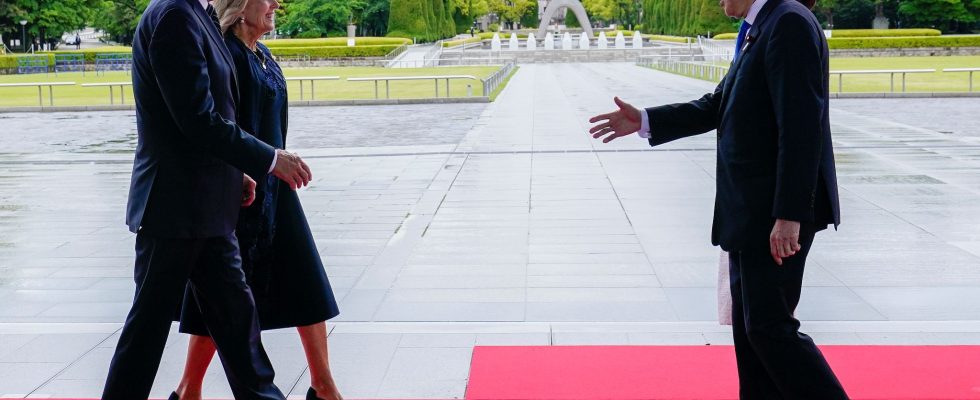The landing of Volodymyr Zelensky on Saturday May 20 in Hiroshima added a dramatic touch to the G7 summit organized in the big city in southwestern Japan. The Ukrainian president came to discuss support for his country with Indian Prime Minister Narendra Modi and his Brazilian counterpart Luis Ignacio Lula da Silva. These leaders did not condemn the Russian invasion launched fifteen months ago, but agreed to meet Zelensky shortly after his arrival. A success for the Ukrainian leader but also, in another register, for the host of the event, Japanese Prime Minister Fumio Kishida.
The G7 has always been an important event for Japan and the preparation for this edition has been particularly meticulous. The man who led Japanese diplomacy from 2012 to 2018 struggled to make it a highlight, carrying a message of peace and unity. Thus, the three-day summit in the prime minister’s hometown saw the leaders of the seven participating countries visit the peace memorial museum, meet a hibakusha (atomic bombing survivor) and lay a wreath at the erected cenotaph. in memory of the victims. A first for a French president and a British head of government. The initiative was intended to lend weight to the G7’s call to “intensify disarmament and non-proliferation efforts, with the ultimate goal of a world without nuclear weapons, without weakening the security of all”. A message as a response to the threats of Russian President Vladimir Putin to use a tactical nuclear weapon.
The “Global South” in the spotlight
In addition to this diplomatic success, Kishida was able to play on the image of the archipelago, less “marked” than that of the Western members of the G7, to re-establish links with the major representatives of the “Global South”, Indonesia, Vietnam and above all India, which is chairing the G20 this year. If Narendra Modi accepted his invitation, it is because he notes a “growing convergence of political, strategic, security and economic interests” with those of Tokyo. In Hiroshima, the Indian Prime Minister came “to amplify the voices and concerns of the countries of the South” and “to promote synergies” with the G20, he explained to the economic daily. Nihon Keizai.
Looking ahead to the G7, Kishida also visited Egypt, Ghana, Kenya and Mozambique, where he reaffirmed the importance of the rule of law by promising leaders to “raise the voice of Africa in the summit discussions”. “The Japanese approach towards the countries of the South takes into account national specificities. Japan does not impose its political system or its principles. It seeks to share certain ideals such as respect for the rule of law”, observes Michitaka Kaiya, analyst of the conservative daily Yomiuri. An approach that seems to appeal to the leaders of this “global South”, who are increasingly demanding a new approach with the G7 countries.
Good diplomatic operation
Also in Hiroshima, Fumio Kishida was able to claim to have “recovered” the summit of the Quadrilateral Dialogue (Quad), which brings together Japanese, Indians, Australians and Americans and remains considered a formal discussion framework, in opposition to activism. from China. The meeting was originally scheduled to be held in Sydney on May 17, but US President Joe Biden had to cancel it due to the budget crisis in Washington.
Finally, the G7 is being held this time in the presence of South Korean President Yoon Suk-yeol, with whom Fumio Kishida began a reconciliation at the end of 2022, already materialized by commitments in the security field. All-out initiatives that reinforce the international stature of the Japanese head of government, both abroad and in his country, where his popularity rating (52%) should still climb.
